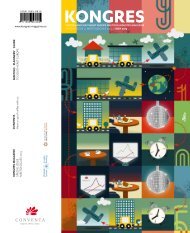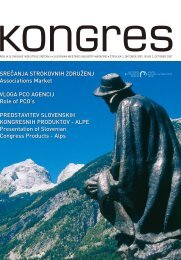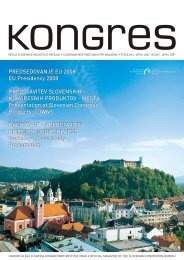EIBTM 2008 Industry Trends & Market Share Report - HCB
EIBTM 2008 Industry Trends & Market Share Report - HCB
EIBTM 2008 Industry Trends & Market Share Report - HCB
Create successful ePaper yourself
Turn your PDF publications into a flip-book with our unique Google optimized e-Paper software.
The financial market crisis of the closing months of <strong>2008</strong> has raised fears of a deep<br />
and prolonged meetings slump in many of the world’s major economies. The impacts<br />
of that crisis will set the context for the meetings and events industry in the shortand<br />
medium-term. By October <strong>2008</strong>, there were already reports of meeting planners<br />
being made redundant and clients cutting back on expenses.<br />
What is the outlook for our industry in the months ahead? As stated in the Preface to<br />
this report, the meetings and events industry has experienced previous periods of<br />
recession. That experience provides a few indications of what is likely to happen this<br />
time round:<br />
* One consensus is that lead times for corporate events will become shorter, as<br />
clients engage in less long-range planning in order to be able to make changes more<br />
rapidly (this tendency was also observed immediately following the 9/11 attacks).<br />
* If companies find it difficult to get credit, the volume of their meetings could<br />
shrink, since many such events are created in order to discuss new business<br />
projects.<br />
* On the association meeting side, if individual members reduce spending - on<br />
personal goods and services, including their attendance at meetings - associations<br />
and the events they hope to stage could be affected by attrition. Nevertheless,<br />
association events generally stick to their schedules even if attendance levels drop.<br />
Recent and reliable data on the likely outlook for the year ahead is in short supply, in<br />
these volatile times. However, two key reports have made predictions, taking into<br />
account the recent financial shock to the global economy.<br />
The first of these is the Global Business Travel Forecast and <strong>Trends</strong> <strong>Report</strong>,<br />
published by American Express Business Travel in October <strong>2008</strong>.<br />
This report predicts that business travel costs will not change significantly in this next<br />
year, and that any increases will be fairly moderate, signalling a halt of a steady<br />
upward climb of costs experienced in recent years.<br />
Table 3:<br />
Forecasted Increases<br />
Region Airfares Hotel Rates<br />
Domestic/Short-<br />
Haul<br />
(Economy Class)<br />
International/Long-<br />
Haul<br />
(Business Class)<br />
North America -3% to 5% 1% to 6%<br />
Europe 0% to 4% 1% to 9%<br />
Latin American<br />
and Caribbean<br />
Japan, Asia<br />
Pacific and<br />
Australia<br />
3% to 5% 2% to 4%<br />
2% to 4%. 5% to 7%.<br />
Mid-<br />
Range<br />
-1% to<br />
6%<br />
0% to<br />
6.5%<br />
4% to<br />
6%<br />
8% to<br />
12%<br />
Upper-<br />
Range<br />
-2% to<br />
4.5%<br />
0% to<br />
5%<br />
3% to<br />
7%<br />
8% to<br />
13%<br />
29








